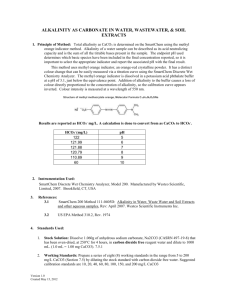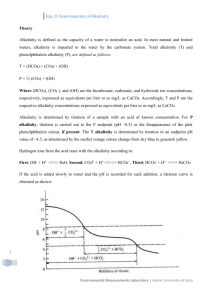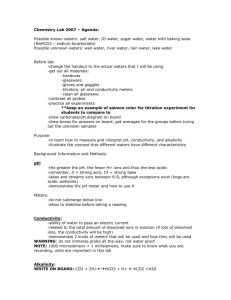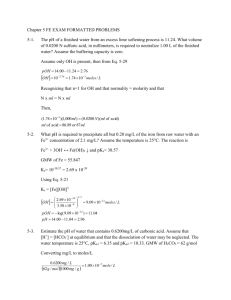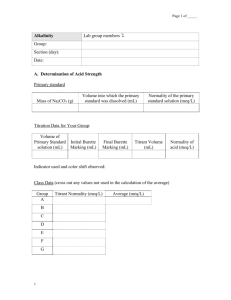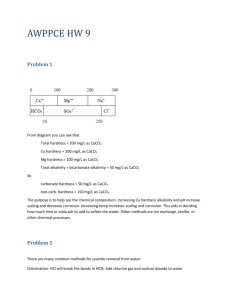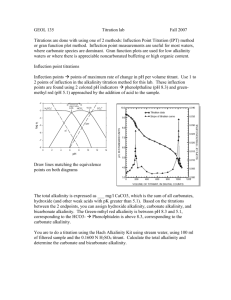Field Methods of Monitoring Atmospheric Systems
advertisement
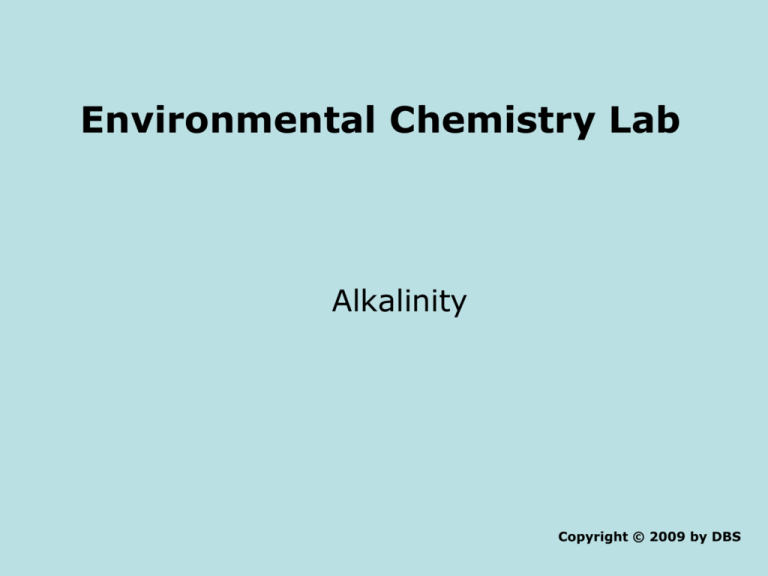
Environmental Chemistry Lab Alkalinity Copyright © 2009 by DBS ‘…nature’s means of keeping the pH neutral, and stable, so that life can exist there’ Alkalinity • Measure of the ability of a water body to neutralize acidity • Three major ions contribute to total alkalinity OHCO32HCO3• • Water supply with high total alkalinity is resistant to pH change Two samples with identical pH but different alkalinity behave differently on addition of acid – Different capacity to neutralize acid Alkalinity Hydroxide Ion NaOH + HCl → H2O + NaCl • Hydroxide ion has the greater capacity of all the alkalinity ions to make water basic • Pure water with a few drops of OH- will have a very high pH • Hydroxide originates from the mineral bed in which the natural water body lies • Becomes soluble as acid components are added • However, because it does react rapidly with acidic components, any hydroxide ion left forms insoluble precipitates • OH- alkalinity is not often encountered in stable natural waters Alkalinity Carbonate Ion • Some carbonates are soluble, some are insoluble • Reacting with a strong acid: – One carbonate reacts with 2 H+ ions: Na2CO3 + 2HCl → H2CO3 + 2NaCl (carbonate changes 2 molec. strong acid to one molec. Weak) • Reacting with a weak acid: Na2CO3 + 2H2CO3 → 2NaHCO3 Carbonate has changed the weak acidinto an almost pH neutral compound (HCO32-) which itself reacts with acid… Alkalinity Bicarbonate Ion • • • In pure water, HCO3- has limited ability to raise pH HCO3- has excellent acid neutralising power Bicarbonate originates from carbonates that have dissolved from the underlying rock NaHCO3 + HCl → H2CO3 + NaCl (Bicarbonate changes one molec. strong acid to one molec. Weak) NaHCO3 + H2CO3 → NR • • • No net change In natural waters there is a balance; these ionic components are always in flux No natural waters can have all three: OH-, CO32-, and HCO3- since OHreacts with HCO32- to form CO32- Alkalinity • Measurement of the buffer capacity (resistance to pH change) e.g. Carbonate neutralization reaction CO32- + H+ ⇌ HCO3Bicarbonate neutralization reaction HCO3- + H+ ⇌ H2O.CO2 ⇌ H2O + CO2 Hydroxide neutralization reaction H+ + OH- ⇌ H2O Alkalinity = [OH-] + [HCO3-] + 2[CO32-] – [H+] • Units are mg L-1 CaCO3 or mEq L-1 (regardless of species) • Acid titration to change the pH to 4.5 (methyl orange end-point) • If pH < 4.5 there is no acid neutralizing capacity i.e. no need to measure alkalinity Colorimetric pH Determination • • Acid-base indicator solution or indicator paper Indicators are large organic molecules that change color depending on pH e.g, cresol red is yellow < 7.0 and red > 8.8 and various shades in between Indicator Color (acidic → basic) pH Range yellow → green 0.2 -1.8 Thymol blue red → yellow yellow → blue 1.2 - 2.8 8.0 - 9.6 Methyl orange red → yellow 3.2 – 4.4 Bromocresol green Yellow → blue 3.8 -5.4 Methyl red Red → yellow 4.8- 6.0 Bromothymol blue Yellow → blue 6.0 - 7.6 Cresol red Yellow → red 7.0 - 8.8 Phenolphthalein Colorless → pink 8.2 - 10.0 Thymolphthalein Colorless → blue 9.4 - 10.6 Yellow → red 10.1 -12.0 Malachite green Alizarin yellow Measuring Total Alkalinity Remove sample from refrigerator ~30 mins prior to analysis Measure on unfiltered samples • To unfiltered sample add strong acid of known concentration, (0.0100 M H2SO4) titrate to pH 4.5 (indicator goes yellow → red) Net ionic: CaCO3 + H2SO4 → H2CO3 + CaSO4 CO32- + 2H+ → H2CO3 • Range 30 - 500 mg CaCO3 L-1 – Rainwater < 10 – Surface water < 200 – Groundwater > 1000 (due to MO decomposition) Indicator • • Methyl Orange: Orange → Rose at pH 4.5 Difficult to see • Bromocresol green: Blue → Yellow at pH 4.5 • More precise indicator is a bromocresol green/methyl red mixture 5.2 – green-blue 5.0 – light blue with lavender grey 4.8 – light pink with blue cast 4.6 light pink Question What is the total alkalinity for a sample requiring 21.25 mL of 0.0100 M H2SO4? 0.02125 L x 0.0100 mol L-1 = 2.125 x 10-4 mol H2SO4 Mole ratio is 1:1 2.125 x 10-4 moles H2SO4 = 2.125 x 10-4 moles CaCO3 2.125 x 10-4 mol CaCO3 x 100.09 g / mol = 2.13 x 10-2 g = 21.3 mg 21.3 mg CaCO3 = 213 mg CaCO3 L-1 0.100 L Calculation • mg/L total Alkalinity, as CaCO3 = mL titrated x 1000 ml/L mL sample Units • Units are mg L-1 CaCO3 or mEq L-1 (regardless of species) mEq L-1 = mg L-1 CaCO3 divided by 50 • CaCO3 + 2H+ ⇌ H2CO3 mg x 1 mmol x 2mEq = mEq L 100 mg mmol L mg x 1/50 = mEq L L Field Method / High-Throughput Labs • Hach Titrator – Cartridge based system – 100 mL cylinder – 250 mL beaker Source: http://www.hach.com Questions • Can an acidic solution have a measureable alkalinity? Yes • What is the difference between alkalinity and buffer capacity? Alkalinity is very much like buffer capacity. Both are extensive factors, but alkalinity is more complex. Several chemical species, both acids and bases can contribute to the alkalinity and the alkalinity can be quite large in magnitude. In contrast BC is generally much smaller in magnitude Text Books • • • • • • • • Rump, H.H. (2000) Laboratory Manual for the Examination of Water, Waste Water and Soil. Wiley-VCH. Nollet, L.M. and Nollet, M.L. (2000) Handbook of Water Analysis. Marcel Dekker. Keith, L.H. and Keith, K.H. (1996) Compilation of Epa's Sampling and Analysis Methods. CRC Press. Van der Leeden, F., Troise, F.L., and Todd, D.K. (1991) The Water Encyclopedia. Lewis Publishers. Kegley, S.E. and Andrews, J. (1998) The Chemistry of Water. University Science Books. Narayanan, P. (2003) Analysis of environmental pollutants : principles and quantitative methods. Taylor & Francis. Reeve, R.N. (2002) Introduction to environmental analysis. Wiley. Clesceri, L.S., Greenberg, A.E., and Eaton, A.D., eds. (1998) Standard Methods for the Examination of Water and Wastewater, 20th Edition. Published by American Public Health Association, American Water Works Association and Water Environment Federation.
